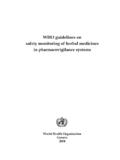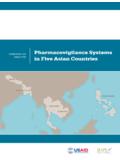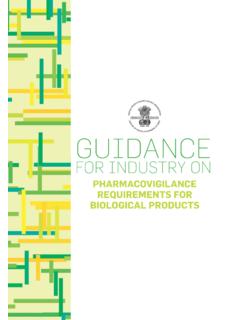Transcription of Guideline on the Regulation of Therapeutic …
1 Guideline on the Regulation of Therapeutic Products in New Zealand Part 8: pharmacovigilance Edition December 2017 Guideline on the Regulation of Therapeutic Products in New Zealand - Part 8 - Edition Page 2 Contents pharmacovigilance .. 1 Contents .. 2 Section 1: Legislation .. 5 Legislation relating to pharmacovigilance .. 5 Section 2: Roles and Responsibilities .. 6 Introduction .. 6 Medsafe .. 6 Statutory Benefit-Risk Review .. 7 Medicines Adverse Reactions Committee .. 7 Centre for Adverse Reactions Monitoring .. 8 Sponsors .. 8 Sponsors obligations and responsibilities .. 8 Contact Person .. 9 Contractual agreements between sponsors, manufacturers, importers or 9 Subcontracting pharmacovigilance functions .. 9 Emergency planning .. 10 Failure to comply with responsibilities and obligations .. 10 Section 3: Reporting .. 11 Introduction .. 11 What should be reported.
2 12 Do NOT report: .. 12 Serious Adverse Event / Adverse Reaction .. 12 Non-serious adverse reactions .. 13 Spontaneous adverse reaction reports (Unsolicited reports) .. 13 Solicited reports .. 13 Reporting process .. 14 Collection of 14 Validation of 14 Follow-up of reports .. 15 Downgrading the seriousness of a case report .. 15 Reporting timeframe for adverse reaction reports .. 15 Special situations .. 16 Guideline on the Regulation of Therapeutic Products in New Zealand - Part 8 - Edition Page 3 Consumer reports .. 16 Adverse Event Following Immunisation .. 16 Lack of efficacy .. 17 Misuse or abuse .. 17 Off-label use .. 18 Medicines supplied under section 25 or section 29 of the Act (unapproved medicines) .. 18 Clinical trials .. 18 Post authorisation studies .. 18 Medication errors .. 18 Overdose or Occupational exposure .. 19 Period after suspension or removal from the market.
3 19 Media reports .. 19 Reports from the scientific and medical literature .. 20 Suspected adverse reactions related to quality defect or falsified medicine .. 20 How to report to CARM .. 21 How to report to Medsafe .. 21 Suspected Medicine Adverse Reaction Search .. 21 Release of information under the Official Information Act .. 22 Section 4: Signal Management Process .. 23 Introduction .. 23 Signal management process .. 23 Signal detection .. 24 Signal validation .. 24 Signal analysis and prioritisation .. 24 Signal assessment .. 25 Outcomes of signal management process .. 25 Quality requirements .. 25 Early Warning System .. 26 Medicines Monitoring .. 26 Section 5: Significant Safety Issues .. 27 Introduction .. 27 What are significant safety issues .. 27 Timeframe for reporting significant safety issues .. 28 How to 28 Guideline on the Regulation of Therapeutic Products in New Zealand - Part 8 - Edition Page 4 Section 6: Submission of Safety Monitoring Documents.
4 29 Introduction .. 29 Submission of PBRERs .. 29 Format of a PBRER .. 30 Risk Management Plans .. 30 RMPs and risk management tools .. 30 How to submit a PBRER or RMP .. 30 Section 7: Safety Communications .. 31 Introduction .. 31 Dear Healthcare Professional letters .. 31 Other safety communications .. 32 Other educational materials .. 32 Section 8: Best Practice Guidelines .. 33 Other New Zealand guidance .. 33 International best practice guidance .. 33 Section 9: Glossary .. 34 Guideline on the Regulation of Therapeutic Products in New Zealand - Part 8 - Edition Page 5 Section 1: Legislation Legislation relating to pharmacovigilance The following legislation should be read by the sponsor in conjunction with this part of the Guideline . Medicines Act 1981 (the Act): Section 8 Advisory and technical committees Section 35 Revocation and suspension of consents Section 36 Control of established medicines Section 41 Duty of importer or manufacturer to report untoward effects of medicines Official Information Act 1982 Privacy Act 1993 This Guideline includes recommendations to the sponsor that are not currently underpinned by medicines legislation.
5 These recommendations aim to provide guidance on best practice of pharmacovigilance . Section summary This section identifies the legislation and guidance documents to be read by the sponsor in conjunction with this part of the regulatory Guideline . Guideline on the Regulation of Therapeutic Products in New Zealand - Part 8 - Edition Page 6 Section 2: Roles and Responsibilities Introduction New Zealand has an established pharmacovigilance system for collecting and evaluating information relevant to the benefits and risks of harm of approved medicines. As described in other parts of this Guideline , before a new medicine is given consent to be distributed in New Zealand, the clinical benefits and risks of harm of the product are considered during the approval process. At the time of approval, the evidence of safety is relatively limited. It is not until the medicine begins to be used widely that additional information may be gathered.
6 Any new information that changes the balance between benefit and risk of harm may affect the acceptability of the medicine. In addition, the evaluation of this balance may change over time as new information becomes available. Medsafe Section 41 of the Medicines Act 1981 requires the Director-General of Health to receive reports of untoward effects from sponsors of medicines. Medsafe is the regulatory unit of the Ministry of Health that has been delegated authority by the Director-General to receive these reports. It is one of Medsafe s functions to continually monitor the benefits and risks of harm of approved medicines. Medsafe detects, investigates and takes action on safety issues arising from safety reports and other sources of information. Post-market reports of suspected adverse reactions to medicines are collected in New Zealand. This activity is contracted by the Ministry of Health to the Centre for Adverse Reactions Monitoring (CARM).
7 Medsafe and CARM work together to identify safety concerns from these reports. After evaluation of the information on a safety issue, Medsafe will make a decision on the most appropriate regulatory action to take. Actions include: no action to be taken at the present time continued monitoring of the situation a request for additional information or studies from the sponsor to gain further evidence on the issue an instruction to sponsors to communicate to healthcare professionals (eg, a Dear Healthcare Professional letter) Section summary This section describes the role of the regulator and the responsibilities and obligations of the sponsor in establishing a risk based approach to the monitoring, reporting, and management of adverse reactions associated with the use of medicines. Guideline on the Regulation of Therapeutic Products in New Zealand - Part 8 - Edition Page 7 a change to the product information (data sheet) suspension of the distribution of the medicine while investigations are ongoing advice to the Minister of Health to revoke consent for the medicine to be distributed.
8 Statutory Benefit-Risk Review Section 36 of the Medicines Act 1981 makes provision for a review of the safety or efficacy of a medicine. This section of the Act allows the Director-General of Health to require the sponsor to provide evidence to support the safety or efficacy of the product . Outcomes of such a review may include imposing conditions on the supply of the medicine or prohibiting the supply of the medicine. Sponsors will be informed in writing if such a review is to be conducted and will be requested to provide evidence to support the efficacy or safety of their product (s). Sponsors have 60 days to respond before any action may be taken. An extension of this time period may be allowed if sponsors can provide adequate justification. Sponsors requiring more information in the event of such a review should contact Medsafe. Medicines Adverse Reactions Committee The Medicines Adverse Reactions Committee (MARC) is a technical advisory committee established under section 8 of the Act to advise the Minister of Health on the safety of approved medicines.
9 The MARC provides expert advice on medicines safety issues referred by Medsafe. Based on review of these safety issues, the MARC may make recommendations to manage any risk of harm associated with the medicine and improve the risk-benefit profiles of medicines. The Chair and other members of the MARC are experts in various fields of clinical medicine, clinical pharmacology, pharmacy, pharmacovigilance , epidemiology and other medical specialties such as cardiology, biostatistics, and medicines Regulation . The MARC also holds a position for a lay person (non-healthcare professional) to represent consumer interests. Members are appointed for a three year term, which may be renewed once for a further three years. The MARC meets four times a year. Secretarial support is provided by Medsafe. Minutes of the meetings are published on the Medsafe website ( ). Reports presented to the MARC are also published on the Medsafe website ( ).
10 Information provided by companies and private information is removed prior to publication. Further information about the MARC is available on the Medsafe website ( ). Guideline on the Regulation of Therapeutic Products in New Zealand - Part 8 - Edition Page 8 Centre for Adverse Reactions Monitoring The Centre for Adverse Reactions Monitoring (CARM) is contracted by the Ministry of Health to collect, collate and analyse adverse medicine reaction reports for Medsafe. Each report submitted to CARM is evaluated by a medical assessor who determines the extent of the association between the adverse reaction(s) described and the medicine(s) involved. CARM uses the World Health Organization (WHO) causality assessment criteria for this evaluation. Routine summary reports of adverse reactions and any individual report or clusters of reports that highlight an issue of concern are provided to Medsafe and the MARC. CARM provides the MARC with a quarterly review of adverse reactions reported in New Zealand.















